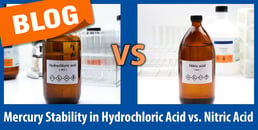
Teledyne Leeman Labs has been in the mercury (Hg) analysis business for more than 30 years. We have had a variety of product lines reach new markets and address tighter regulations. In that time, one thing has remained constant across all our instruments: the need for accurate mercury standards to form the building blocks of the calibration curve. Analytical results are only as reliable as the calibration curve to which they are compared, and creating stable mercury standards comes with unique challenges.
The stability of mercury solutions has always been an item of concern for trace analysis determinations. Studies have concluded the following, which are generally accepted in the scientific community:
- Hg is more stable in borosilicate glass than low density polyethylene (LDPE)/ high density polyethylene (HDPE) containers.1
- Hg is more stable in hydrochloric acid (HCl) or aqua regia than nitric acid (HNO3) 2,3, 4
- Hg is more stable over time in higher Hg concentrations.3
In a native water sample, there are anions in solution to bind with the mercury. But in laboratory-made standards, deionized (DI) water is used. While this removes contaminates and interferences, it also removes the stabilizing effect of the ions. This is why an acid must be added to DI water before the addition of Hg standards. It provides the ions needed to greatly improve the stability of the Hg sample. In the presence of HCl, mercury forms the stable complex [HgCl4]2-. Formation of this complex is thought to reduce the adsorption of Hg on the inner walls of containers, which can lead to erratic results.2
If the Hg standard is made directly in the container that will be used throughout the entire analysis, it may be possible to use nitric acid. In that case, the Hg that has been lost to the matrix of the container will be subjected to the complete digest and return the Hg back to the solution.
But most laboratories create working and intermediate standards separately in volumetric flasks, then distribute aliquots to individual sample vials. If that is the case, nitric is not the preferred acid for stabilization. There is a high chance the Hg is adhered to the walls of the vessel and not represented properly in the aliquots removed to make the individual samples. This will lead to widely variable and unpredictable results — a real head scratcher when you’ve followed the standard operating procedure to the letter.
Using nitric acid to stabilize mercury standards in this way is a remnant from making standards and samples in 300mL BOD bottles, which has fallen out of favor as technology and methodology has progressed since many of these methods were introduced in the 1970’s and revised in the 1990’s. The same is true for purchasing commercially available Hg stock standards instead of making them from mercuric chloride salts and using stannous chloride solutions instead of stannous sulfate suspensions for the reduction. But I digress.
Customers often ask for manufacturers’ recommendations when sourcing reagents for standard preparation. For hydrochloric acid, it is advised to purchase 37% hydrochloric acid ACS grade, or trace metals grade for ultra-trace analysis. For nitric acid, it is advised to purchase 67-70% nitric acid ACS grade, or trace metals grade for ultra-trace analysis. This will be used for making Hg standards and rinse solution for the instruments.
For a Hg stock standard, it is advised to purchase one that meets the following criteria:
- Single element Hg standard specifically for Atomic Absorption Spectroscopy (AAS).
- 1000 µg/mL (ppm)
- in 10-12% HNO3
Single element aqueous certified reference materials (CRM) are not acceptable. Lower concentrations of Hg or acid will shorten the reliability of the stock standard over time. Opening the bottle frequently will also shorten the shelf-life. It is also important to note that the expiration date listed on the container is often for unopened bottles. It is essential to have SOP in place to dictate chemical expirations in the laboratory after opening chemical bottles.
Another frequently asked question is which acids to use for sample preservation and sample digestions. Often the prescriptive language of U.S. Environmental Protection Agency methods prohibits changes to sample preservation techniques or hold times. These are typically using small volumes of HNO3 to bring the pH <2.5,7 Others use HCl or bromine monochloride (BrCl) solution, which is made with concentrated HCl.6
However, for the sample digestion it is often permissible to substitute equivalent chemical types if quality is still assured. Teledyne Leeman Labs always advises using 3% HCl as the diluent for Hg working standards or sample dilutions on its QuickTrace systems. The HCl forms a complex with the mercury, which keeps the Hg in solution more effectively compared to using HNO3. This will provide consistent and reproducible results when analyzing for mercury.
Feel free to contact us to discuss your unique analytical circumstances. Our applications specialists and technical support team are happy to answer your questions about properly operating your QuickTrace mercury analyzers.
References:
- https://www.inorganicventures.com/guides-and-papers/mercury-chemical-stability
- https://pubs.rsc.org/en/content/articlelanding/2012/ay/c2ay05182f
- https://www.inorganicventures.com/advice/stability-of-mercury-in-plastic-bottles
- https://www2.gov.bc.ca/assets/gov/environment/research-monitoring-and-reporting/monitoring/emre/methods/sample_preparation_for_dissolved_metals_or_mercury_in_water__pbm.pdf
- https://www.epa.gov/sites/default/files/2015-07/documents/epa-7470a.pdf
- https://www.epa.gov/sites/default/files/2015-08/documents/method_1631e_2002.pdf
- https://www.epa.gov/sites/default/files/2015-08/documents/method_245-7_rev_2_2005.pdf
For more information on Leeman Labs Mercury Analyzers or if you would like to someone to contact you - click the button below.

